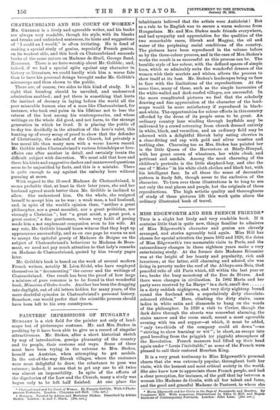MISS EDGE WORTH AND HER FRENCH FRIENDS.* THis is a
slight but lively and very readable book. If it contains little that is quite new, things familiar to admirers of Miss Edgeworth's character and genius are cleverly arranged, and stories agreeably told again. Miss Hill has chosen for special attention the years 1802 and 1820, the dates of Miss Edgeworth's two memorable visits to Paris, and the extraordinary changes in those eighteen years make a very entertaining study. At the former date Madame Recamier was at the height of her beauty and popularity, rich and luxurious ; at the latter, still charming and adored, she was living in poverty under the roof of the Abbaye-aux-Bois, that peaceful relic of old Paris which, till within the last year or two, broke the busy monotony of the Rue de Sevres. And there were changes in civilisation. In 1802 Maria and her
party were received by La Harpe " in a dark, small den in a dirty reddish nightgown, and very dirty nightcap bound round the forehead with a superlatively dirty chocolate- coloured ribbon." Here, climbing the dirty stairs, came ladies in white satin and diamonds to bang on the words of the philosopher. In 1820 a visit to Cuvier, though the dark drive through the streets was somewhat alarming, the stairs narrow and the room small, meant a most agreeable evening with tea and supper—at which, it must be added, "only two-thirds of the company could sit down"—no "striving to show learning or wit " ; in short, an escape into good breeding from the priggish (or piggish) atmosphere of the Revolution. French manners had lifted up their head again under "Louis l'inevitable," as some of the French were pleased to call their restored Bourbon King.
It is a very great testimony to Miss Edgeworth's personal charm that she was extremely popular, throughout both her visits, with the keenest and most critical society in the world. She also knew how to appreciate these French people, and had a clear perception, for instance, of the gulf that lay between a woman like Madame de Genlis, with all her talent and fame, and the good and graceful Madame de Pastoret, to whom she
• Maria Edgeworth and her Circle in the Days of Buonapacts and Bourbon. By Constance Hill. With numerous Illustrations by Ellen G. Hill, and Repro- dnctions of Contemporary Portraits. London : John Lane. [21s. net]
wrote in an unpublished farewell letter quoted by Miss Hill : "I am afraid that we return to our own country with too strong a taste for the elegance and facility of French society." It is only privileged persons who experience that "facility." But it seems that Maria, besides speaking French perfectly well, was an incomparable listener.
The interest of the book is not confined to these two visits to Paris. It has amusing stories of English as well as French society between the dates we have mentioned. Various quaint literary figures of the time are agreeably presented : in fact, there is scarcely a famous name in France or EnglItnd with whom the brilliant Irish writer had not some acquaint- ance or connexion, and the effect of the whole book is that of a series of pleasant social pictures taken from the first twenty years of the nineteenth century. We may add that the illustrations, most of them original, are particularly interesting.























































 Previous page
Previous page